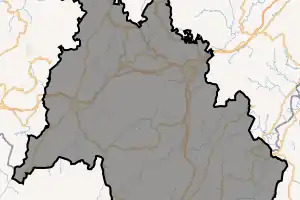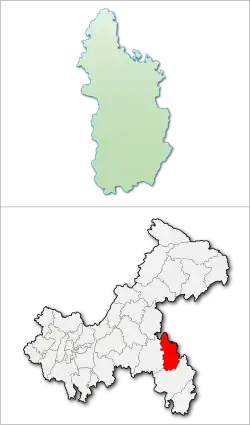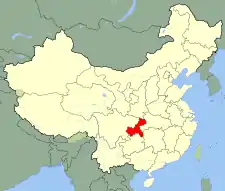Qianjiang District
Qianjiang District (formerly Qianjiang Tujia and Miao Autonomous County, simplified Chinese: 黔江区; traditional Chinese: 黔江區; pinyin: Qiánjiāng Qū) is a district (formerly autonomous county) in the southeastern part of Chongqing Municipality, People's Republic of China, bordering Hubei province to the east and northeast. While it is governed as a district, in practice Qianjiang is its own city proper far removed from the urban centre of Chongqing. The Miao and Tujia ethnic groups constitute 50.03% of the Qianjiang population, the other half being mostly Han (49.94%). Qianjiang is nicknamed "The Throat of Sichuan and Hubei" (川鄂咽喉) because it sits on the intersection of Sichuan-Hubei and Sichuan-Hunan Roads.
Qianjiang
黔江区 Kienkiang | |
|---|---|
 | |

| |
 Qianjiang District in Chongqing | |
| Coordinates (Qianjiang government): 29°32′01″N 108°46′15″E | |
| Country | People's Republic of China |
| Municipality | Chongqing |
| Seat | Chengxi Subdistrict |
| Area | |
| • Total | 2,397 km2 (925 sq mi) |
| Population (2009) | |
| • Total | 545,000 |
| • Density | 230/km2 (590/sq mi) |
| Time zone | UTC+8 (China Standard) |
There used to be a large region called Qianjiang Prefecture containing the contemporary jurisdiction area of Qianjiang District (see history below).
History
Qianjiang District used to be a county under a now-abolished prefecture (later development area) by the same name.
At the beginning of the Han Dynasty, Qianjiang was administratively part of the Fuling District. In 585 (during the Sui Dynasty), Shicheng District (石城县) was established as part of Yong Prefecture (庸州), with the district seat at today's Ba Village of Baxiang County (坝乡县坝村). In 607, Yong Prefecture was replaced by Badong Commandery (巴东郡). In 618 (the Tang Dynasty), Shicheng became part of Qian Prefecture (黔州), with district seat at Wuci Town (无慈城) and, in 630, Lienche Town.
In 742, Shicheng was renamed Qianjiang and was part of An Commandry (安郡). From 960 to 1368 (Song and Yuan), Qianjiang at this time was "half-barbarian" (半没于夷) and dominated by the local rich bourgeois of the Gongs, Hus, Qins, and Xiangs (龚、胡、秦、向) according to the Qianjiang County Records (黔江县志) of the Qing Dynasty.
In 1285 (late Yuan), Qianjiang was part of Ming Yuzhen's Daxia Empire. In 1372, it was part of Pengshui District. In 1378, 1216 soldiers were dispatched here to guard the place.
In early Qing, Qianjiang District was under Chongqing Subprefecture.
In 1912, Qianjiang County was under Liuxiang Fangqu (刘湘防区). In 1935, it was under of the Eighth Administrative Region (第八行政督察区) of Sichuan Province, also known as Youyang Special District (酉阳专区). The county seat was at Sanduo Town (三多镇).
On November 12, 1949, Qianjiang came under CPC control, and the People's Government was established on November 25, as part of Chuandong Administrative Special District (川东行政专区). The county seat changed to Lianhe Town (联合). On January 23, 1950, it was under Youyang Special District, which also administered Youyang and Xiushan Counties. In September 1952, Youyang was merged into Fuling Special District.
On November 14, 1983, the State Council approved to change the county status to a Tujia and Miao autonomous county: Qianjiang Tujia and Miao Autonomous County (黔江土家苗族自治县). The assembly was established November 13 of the following year.
On May 18, 1988, the State Council halved Fuling, making Qianjiang County, as well as four other counties (5 autonomous counties of Fuling's 10 counties), into a new prefecture: Qianjiang Prefecture. The other four counties were:
- Shizhu Tujia Autonomous County (石柱土家族自治县)
- Pengshui Miao and Tujia Autonomous County (彭水苗族土家族自治县)
- Youyang Tujia and Miao Autonomous County (酉阳土家苗族自治县)
- Xiushan Tujia and Miao Autonomous County (秀山土家苗族自治县)
The prefecture officially began in November. At this time the area was 16,900 km2 with a population of 2,700,000.
Qianjiang County, along with Qianjiang District, was incorporated into Chongqing Municipality in 1997. On March 17, 1997 (implemented on December 20), the prefecture status was changed to a development area (开发区), which governs Shizhu, Xiushan, Qianjiang County, Pengshui and Youyang on behalf of Chongqing. On May 22, 1998 (implemented June 2000), Qianjiang Development Area and Qianjiang Autonomous County were abolished. Qianjiang Autonomous County became Qianjing District (the subject of this article), directly administered by Chongqing. Shizhu, Xiushan, Pengshui and Youyang remain autonomous counties, and are governed by Chonqging directly as well.
Transport
Qianjiang is located on the border between Chongqing Municipality and Hubei and Hunan provinces. The G65 Baotou–Maoming Expressway connects Qianjiang with the Chongqing city proper to the west and the city of Huaihua to the southeast. On G65, the drive to Chongqing city proper could take more than four hours. China National Highway 319 also runs through Qianjiang.
Qianjiang is served by the Qianjiang Wulingshan Airport, a regional airport with connections to Chongqing, Beijing, Guangzhou, Chengdu, and Kunming.
Administrative divisions
As of 2001, the district contains 3 sub-districts, 12 townships, 15 towns, and 489 village committees. (See Administrative divisions of the People's Republic of China#Levels)
| Name | Chinese (S) | Hanyu Pinyin | Population (2010)[1] | Area (km2) |
|---|---|---|---|---|
| Chengdong Subdistrict | 城东街道 | Chéngdōng Jiēdào | 71,304 | 50 |
| Chengnan Subdistrict | 城南街道 | Chéngnán Jiēdào | 33,844 | 70 |
| Chengxi Subdistrict | 城西街道 | Chéngxī Jiēdào | 38,579 | 89.734 |
| Zhengyang Subdistrict | 正阳街道 | Zhèngyáng Jiēdào | 12,998 | 43.89 |
| Zhoubai Subdistrict | 舟白街道 | Zhōubái Jiēdào | 25,147 | 85.13 |
| Fengjia Subdistrict | 冯家街道 | Féngjiā Jiēdào | 21,810 | 51 |
| Apengjiang town | 阿蓬江镇 | Āpéngjiāng Zhèn | 18,596 | 174 |
| Shihui town | 石会镇 | Shíhuì Zhèn | 15,205 | 128 |
| Heixi town | 黑溪镇 | Hēixī Zhèn | 14,810 | 94 |
| Huangxi town | 黄溪镇 | Huángxī Zhèn | 9,862 | 70 |
| Lishui town | 黎水镇 | Líshuǐ Zhèn | 8,896 | 82 |
| Jinxi town | 金溪镇 | Jīnxī Zhèn | 8,940 | 42 |
| Mala town | 马喇镇 | Mǎlǎ Zhèn | 11,813 | 91 |
| Zhuoshui town | 濯水镇 | Zhuóshuǐ Zhèn | 20,386 | 105 |
| Shijia town | 石家镇 | Shíjiā Zhèn | 9,629 | 104 |
| Echi town | 鹅池镇 | Échí Zhèn | 8,581 | 73.2 |
| Xiaonanhai town | 小南海镇 | Xiǎonánhǎi Zhèn | 6,662 | 115 |
| Lin'e town | 邻鄂镇 | Lín'è Zhèn | 9,942 | 50 |
| Zhongtang Township | 中塘乡 | Zhōngtáng Xiāng | 11,324 | 80.47 |
| Pengdong Township | 蓬东乡 | Péngdōng Xiāng | 6,066 | 34.9 |
| Shaba Township | 沙坝乡 | Shābà Xiāng | 11,414 | 80 |
| Baishi Township | 白石乡 | Báishí Xiāng | 11,706 | 95 |
| Shanling Township | 杉岭乡 | Shānlǐng Xiāng | 6,753 | 54 |
| Taiji Township | 太极乡 | Tàijí Xiāng | 8,242 | 64 |
| Shuitian Township | 水田乡 | Shuǐtián Xiāng | 5,984 | 40 |
| Baitu Township | 白土乡 | Báitǔ Xiāng | 5,188 | 66 |
| Jindong Township | 金洞乡 | Jīndòng Xiāng | 7,070 | 96.33 |
| Wuli Township | 五里乡 | Wǔlǐ Xiāng | 8,010 | 50 |
| Shuishi Township | 水市乡 | Shuǐshì Xiāng | 9,170 | 103 |
| Xinhua Township | 新华乡 | Xīnhuá Xiāng | 7,081 | 76 |
When still a county (pre-2000), Qianjiang had 5 towns, 45 townships, 8 neighborhood committees, and 517 village committees. Many townships were abolished, the only abolished town was Lianhe (联合), the old county seat now separated into sub-districts.
References
- Census Office of the State Council of the People's Republic of China; Population and Employment Statistics Division of the National Bureau of Statistics of the People's Republic of China (2012). 中国2010人口普查分乡、镇、街道资料 (1 ed.). Beijing: China Statistics Print. ISBN 978-7-5037-6660-2.

